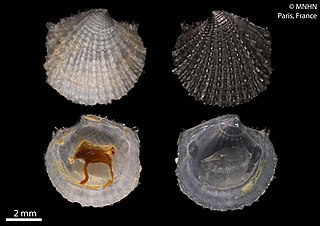
The Noctuidae, commonly known as owlet moths, cutworms or armyworms, are a family of moths. They are considered the most controversial family in the superfamily Noctuoidea because many of the clades are constantly changing, along with the other families of the Noctuoidea. It was considered the largest family in Lepidoptera for a long time, but after regrouping Lymantriinae, Catocalinae and Calpinae within the family Erebidae, the latter holds this title now. Currently, Noctuidae is the second largest family in Noctuoidea, with about 1,089 genera and 11,772 species. This classification is still contingent, as more changes continue to appear between Noctuidae and Erebidae.

A cold seep is an area of the ocean floor where seepage of fluids rich in hydrogen sulfide, methane, and other hydrocarbons occurs, often in the form of a brine pool. Cold does not mean that the temperature of the seepage is lower than that of the surrounding sea water; on the contrary, its temperature is often slightly higher. The "cold" is relative to the very warm conditions of a hydrothermal vent. Cold seeps constitute a biome supporting several endemic species.

Umbellularia californica is a large hardwood tree native to coastal forests and the Sierra foothills of California, and to coastal forests extending into Oregon. It is endemic to the California Floristic Province. It is the sole species in the genus Umbellularia.

Angelsharks are sharks belonging to the genus Squatina. They are the only living members of the family Squatinidae and order Squatiniformes. They commonly inhabit sandy seabeds close to 150 m (490 ft) in depth.

The California sea hare is a species of sea slug in the sea hare family, Aplysiidae. It is found in the Pacific Ocean, off the coast of California in the United States and northwestern Mexico.

Joseph Mellick Leidy was an American paleontologist, parasitologist and anatomist.

The California scrub jay is a species of scrub jay native to western North America. It ranges from southern British Columbia throughout California and western Nevada near Reno to west of the Sierra Nevada. The California scrub jay was once lumped with Woodhouse's scrub jay and collectively called the western scrub jay. The group was also lumped with the island scrub jay and the Florida scrub jay; the taxon was then called simply scrub jay. The California scrub jay is nonmigratory and can be found in urban areas, where it can become tame and will come to bird feeders. While many refer to scrub jays as "blue jays", the blue jay is a different species of bird entirely.

Lucinidae, common name hatchet shells, is a family of saltwater clams, marine bivalve molluscs.

Spisula is a genus of medium-sized to large marine bivalve mollusks or clams in the subfamily Mactrinae of the family Mactridae, commonly known as surf clams or trough shells.
Dr. William Marbury Carpenter, a noted Southern natural scientist.

Phragmatopoma californica, commonly known as the sandcastle worm, the honeycomb worm or the honeycomb tube worm, is a reef-forming marine polychaete worm belonging to the family Sabellarididae. It is dark brown in color with a crown of lavender tentacles and has a length of up to about 7.5 centimeters (3.0 in). The worm inhabits the Californian coast, from Sonoma County to northern Baja California.

Cerithideopsis californica, common name the California hornsnail or the California horn snail, is a species of sea snail, a marine gastropod mollusk in the family Potamididae. This series was previously known as Cerithidea californica.

Codakia is a genus of saltwater clams, marine bivalve molluscs in the family Lucinidae.
Stewartia floridana is a bivalve of the family Lucinidae that is chemosymbiotic with sulfur-oxidizing bacteria.

Lucina is a genus of saltwater clams, marine bivalve molluscs.

Modiolus capax, common name fat horsemussel, is a species of "horse mussel", a marine bivalve mollusc in the family Mytilidae, the mussels. It was first described to science by American malacologist Timothy Abbott Conrad in 1837. The type specimen was collected in San Diego by Thomas Nuttall.

Codakia distinguenda, the elegant lucine, is a species of marine bivalve mollusc. It was first described to science in 1872 by George Washington Tryon Jr.

Lucinisca is a genus of saltwater clams, marine bivalve molluscs in the subfamily Lucininae of the family Lucinidae.

Lucinoma is a genus of saltwater clams, marine bivalve molluscs in the subfamily Codakiinae of the family Lucinidae.

Pandora is a genus of small saltwater clams, marine bivalves in the family Pandoridae.


















